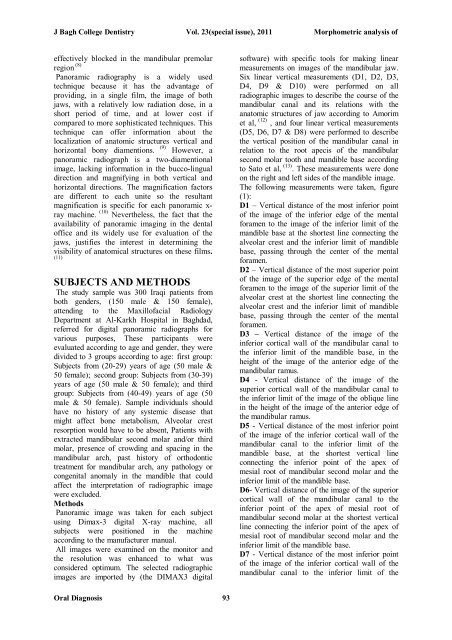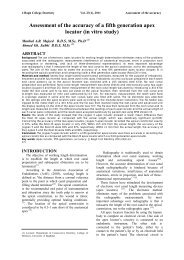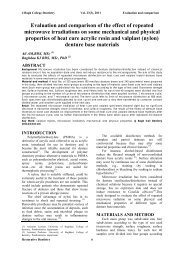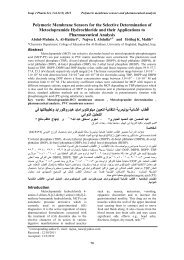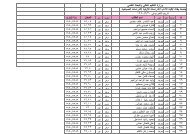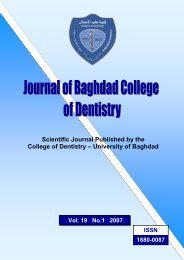Sura F
Sura F
Sura F
Create successful ePaper yourself
Turn your PDF publications into a flip-book with our unique Google optimized e-Paper software.
J Bagh College Dentistry Vol. 23(special issue), 2011 Morphometric analysis of<br />
effectively blocked in the mandibular premolar<br />
region (8)<br />
Panoramic radiography is a widely used<br />
technique because it has the advantage of<br />
providing, in a single film, the image of both<br />
jaws, with a relatively low radiation dose, in a<br />
short period of time, and at lower cost if<br />
compared to more sophisticated techniques. This<br />
technique can offer information about the<br />
localization of anatomic structures vertical and<br />
(9)<br />
horizontal bony diamentions. However, a<br />
panoramic radiograph is a two-diamentional<br />
image, lacking information in the bucco-lingual<br />
direction and magnifying in both vertical and<br />
horizontal directions. The magnification factors<br />
are different to each unite so the resultant<br />
magnification is specific for each panoramic x-<br />
ray machine. (10) Nevertheless, the fact that the<br />
availability of panoramic imaging in the dental<br />
office and its widely use for evaluation of the<br />
jaws, justifies the interest in determining the<br />
visibility of anatomical structures on these films.<br />
(11)<br />
SUBJECTS AND METHODS<br />
The study sample was 300 Iraqi patients from<br />
both genders, (150 male & 150 female),<br />
attending to the Maxillofacial Radiology<br />
Department at Al-Karkh Hospital in Baghdad,<br />
referred for digital panoramic radiographs for<br />
various purposes, These participants were<br />
evaluated according to age and gender, they were<br />
divided to 3 groups according to age: first group:<br />
Subjects from (20-29) years of age (50 male &<br />
50 female); second group: Subjects from (30-39)<br />
years of age (50 male & 50 female); and third<br />
group: Subjects from (40-49) years of age (50<br />
male & 50 female). Sample individuals should<br />
have no history of any systemic disease that<br />
might affect bone metabolism, Alveolar crest<br />
resorption would have to be absent, Patients with<br />
extracted mandibular second molar and/or third<br />
molar, presence of crowding and spacing in the<br />
mandibular arch, past history of orthodontic<br />
treatment for mandibular arch, any pathology or<br />
congenital anomaly in the mandible that could<br />
affect the interpretation of radiographic image<br />
were excluded.<br />
Methods<br />
Panoramic image was taken for each subject<br />
using Dimax-3 digital X-ray machine, all<br />
subjects were positioned in the machine<br />
according to the manufacturer manual.<br />
All images were examined on the monitor and<br />
the resolution was enhanced to what was<br />
considered optimum. The selected radiographic<br />
images are imported by (the DIMAX3 digital<br />
software) with specific tools for making linear<br />
measurements on images of the mandibular jaw.<br />
Six linear vertical measurements (D1, D2, D3,<br />
D4, D9 & D10) were performed on all<br />
radiographic images to describe the course of the<br />
mandibular canal and its relations with the<br />
anatomic structures of jaw according to Amorim<br />
et al, (12) , and four linear vertical measurements<br />
(D5, D6, D7 & D8) were performed to describe<br />
the vertical position of the mandibular canal in<br />
relation to the root apecis of the mandibular<br />
second molar tooth and mandible base according<br />
to Sato et al, (13) . These measurements were done<br />
on the right and left sides of the mandible image.<br />
The following measurements were taken, figure<br />
(1):<br />
D1 – Vertical distance of the most inferior point<br />
of the image of the inferior edge of the mental<br />
foramen to the image of the inferior limit of the<br />
mandible base at the shortest line connecting the<br />
alveolar crest and the inferior limit of mandible<br />
base, passing through the center of the mental<br />
foramen.<br />
D2 – Vertical distance of the most superior point<br />
of the image of the superior edge of the mental<br />
foramen to the image of the superior limit of the<br />
alveolar crest at the shortest line connecting the<br />
alveolar crest and the inferior limit of mandible<br />
base, passing through the center of the mental<br />
foramen.<br />
D3 – Vertical distance of the image of the<br />
inferior cortical wall of the mandibular canal to<br />
the inferior limit of the mandible base, in the<br />
height of the image of the anterior edge of the<br />
mandibular ramus.<br />
D4 - Vertical distance of the image of the<br />
superior cortical wall of the mandibular canal to<br />
the inferior limit of the image of the oblique line<br />
in the height of the image of the anterior edge of<br />
the mandibular ramus.<br />
D5 - Vertical distance of the most inferior point<br />
of the image of the inferior cortical wall of the<br />
mandibular canal to the inferior limit of the<br />
mandible base, at the shortest vertical line<br />
connecting the inferior point of the apex of<br />
mesial root of mandibular second molar and the<br />
inferior limit of the mandible base.<br />
D6- Vertical distance of the image of the superior<br />
cortical wall of the mandibular canal to the<br />
inferior point of the apex of mesial root of<br />
mandibular second molar at the shortest vertical<br />
line connecting the inferior point of the apex of<br />
mesial root of mandibular second molar and the<br />
inferior limit of the mandible base.<br />
D7 - Vertical distance of the most inferior point<br />
of the image of the inferior cortical wall of the<br />
mandibular canal to the inferior limit of the<br />
Oral Diagnosis 93


